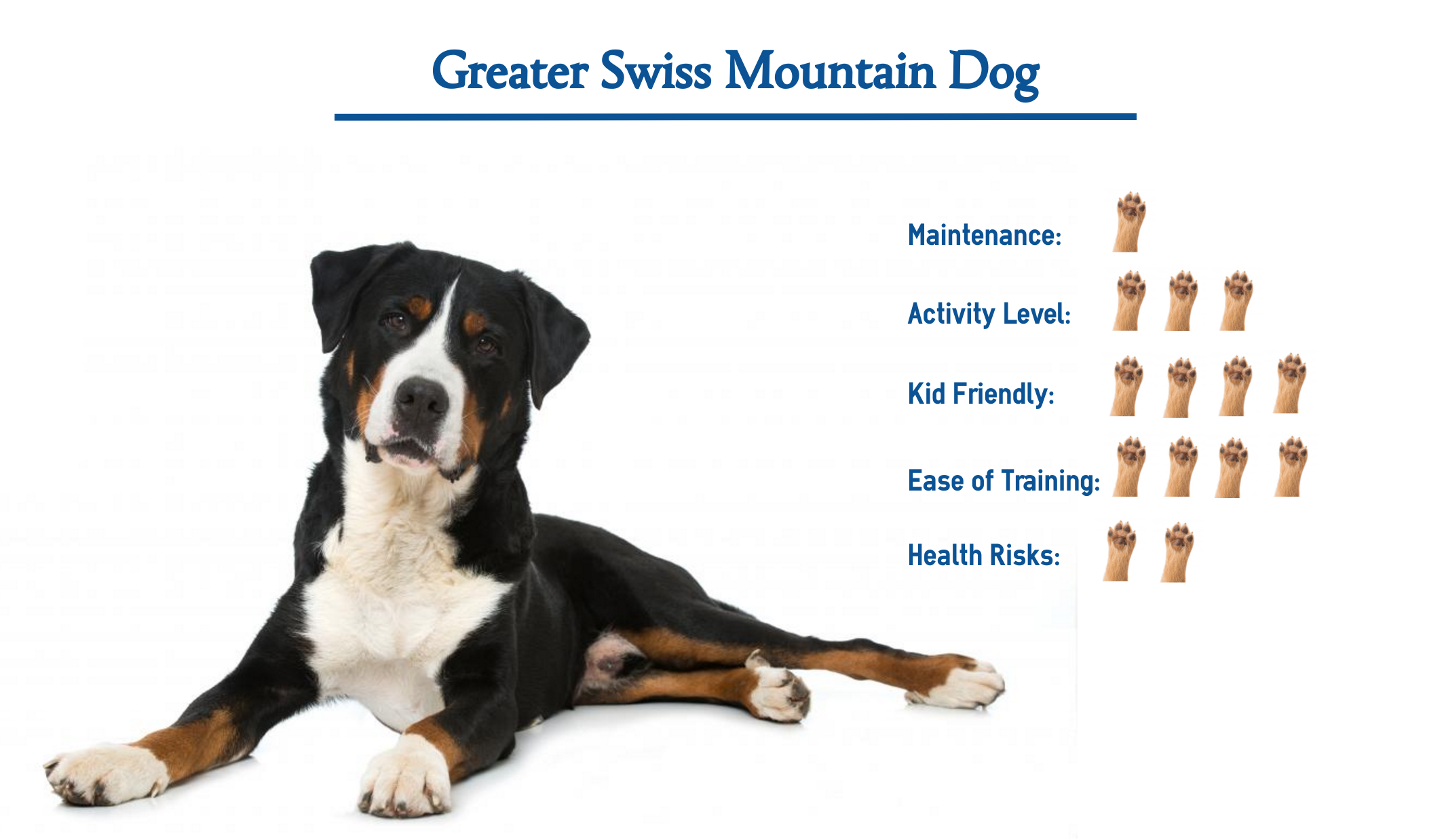Greater Swiss Mountain Dog Guide: Everything You Need To Know
Is the Greater Swiss Mountain Dog the right breed for you? These majestic, tri-colored canines, with their impressive size and gentle demeanor, may be the perfect addition to your family, but understanding their specific needs is crucial before welcoming one into your home.
As their name suggests, the Greater Swiss Mountain Dog, often referred to as "Swissies," hails from Switzerland. They are one of the four Swiss Mountain Dog breeds, also known by their German name, Grosser Schweizer Sennenhund. Tracing their lineage back to the Roman era, these dogs share ancestry with Roman Molossians and Mastiffs, hinting at their robust build and working heritage. Historically, these dogs were bred for various tasks, including pulling heavy carts, herding dairy cattle, and serving as watchdogs and family companions. The breed's versatility and adaptability have allowed them to thrive throughout the centuries.
The Greater Swiss Mountain Dog stands as the oldest and largest of the four Swiss Mountain Dog varieties still recognized today. The other three breeds which also share the Swiss Mountain Dog lineage are:
| Aspect | Details |
|---|---|
| Name | Greater Swiss Mountain Dog (Grosser Schweizer Sennenhund) |
| Origin | Switzerland |
| Ancestry | Roman Molossians, Mastiffs |
| Historical Roles | Draft dog, herding dog, watchdog, family companion |
| Temperament | Gentle, loyal, friendly |
| Physical Characteristics | Large, tri-colored coat (black, white, and rust), muscular build |
| Grooming Needs | Relatively easy to groom |
| Health Considerations | Potential for minor health issues (e.g., hip dysplasia) |
| Exercise Needs | Moderate; needs space to roam |
| Lifespan | Relatively average for large breeds |
For additional, detailed information, you can explore the American Kennel Club (AKC) website: AKC Greater Swiss Mountain Dog
One of the appealing aspects of owning a Greater Swiss Mountain Dog is their relatively low-maintenance grooming needs. Unlike some breeds with more demanding coat types, the Swissy doesn't require excessive brushing or professional grooming, although regular care is still essential to maintain their healthy coat and skin. This is a plus for owners.
The distinctive appearance of the Greater Swiss Mountain Dog adds to their charm. They're easily recognized by their tri-colored coat, with black generally dominating the body and striking brown markings, or rust as it is often called, prevailing over the legs, chest and around the eyes. The white markings are usually found on the chest, paws, and muzzle, creating a beautiful and balanced aesthetic.
When considering adding a Greater Swiss Mountain Dog to your family, it's essential to be aware of their dietary requirements. This is a large breed, but thankfully, they aren't excessively active. Therefore, they do not require a huge amount of food.
The Swissy's history is one of resilience and revival. In the late 19th century, the breed, along with other Swiss Mountain Dogs, faced a decline in numbers. Fortunately, dedicated enthusiasts recognized the value of these dogs. Their efforts led to the founding of dog clubs, such as the one in 1899 for Bernese Mountain Dog breeders. Then in 1908, Professor Albert Heim and Franz Schertenleib joined forces to rescue some of the remaining dogs from remote alpine villages. This resurgence and the preservation of their bloodlines allowed them to flourish once again in the early 1900s.
The Greater Swiss Mountain Dog is renowned for its gentle and friendly temperament. They are known to be remarkably kind and tolerant, which makes them excellent family pets. Their strength and size can sometimes be underestimated, but it is balanced by their inherent gentle nature.
The physical characteristics are something to consider. Females typically measure between 23.5 and 27 inches at the shoulder. Knowing the average size of the breed can help in determining their requirements.
When deciding whether a Greater Swiss Mountain Dog is the right breed for you, its important to consider several key factors, including health, exercise, and socialization. Like all dog breeds, they have the potential to develop genetic health problems, such as hip dysplasia, so its important to choose a responsible breeder who conducts health screenings. They do need space to roam, despite not being overly active. Early socialization is also important to ensure they become well-adjusted adults.
What you will need to prepare for a puppy is crucial for the new owner, You will need a crate, time and patience. They are known to suffer from some minor health issues, and you should be aware of these issues before acquiring a puppy.
Finding a good breeder is paramount. There are good Facebook pages dedicated to the breed to get you started, which offer valuable insights and resources to find a reputable breeder. Run from any breeder who does not offer a health guarantee on puppies or tells you that the breed has no known problems or keeps puppies isolated from the others. The best breeders provide a good start for the new puppy, ensuring it has the best temperament, the best health and socialization, as well as all health checks.
Bernese Mountain Dogs, another Swiss breed, provide a similar history. They were developed in Bern, Switzerland, and received recognition from the American Kennel Club (AKC) in 1937. Their popularity also waned at one point, and the Bernese Mountain Dog Club of America (BMDCA) reported that the breed was nearly extinct.
When considering the right breed for you, it's essential to consider your lifestyle and the needs of the dog. The Greater Swiss Mountain Dog can bring immense joy and companionship to the right home.



Detail Author:
- Name : Elmer Lowe
- Email : mfritsch@osinski.info
- Birthdate : 1978-06-09
- Address : 9015 Turcotte Rest Apt. 156 Jenkinsborough, NE 56658
- Phone : (725) 891-9708
- Company : Welch-Bauch
- Job : Counselor
- Bio : Odio odit quia eius enim ex iusto illum est. Rerum consequatur quis voluptatum error enim dolorem qui. Minima ipsa nam sunt ducimus consectetur necessitatibus.